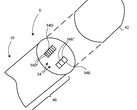While Intel is still struggling to bring its desktop chip technology to its 10nm node, TSMC is forging ahead with its plans for its new 5nm node. In a conference call today, the company revealed that chips fabricated using the new process will contribute around 8 percent to its revenue for the next quarter. The company also outlined some of the performance gains inherent to the node that we can expect to see first in Apple’s upcoming A14 SoC and later Qualcomm’s Snapdragon 875.
One of the reasons that chip makers are keen to move to smaller nodes is that on a molecular level, the atoms are more densely packed. This allows the electrons to move more quickly and efficiently throughout the chip architecture without even needing to design the chip itself. In this instance, TSMC says moving from its 7nm node to its new 5nm node will yield performance gains of 15 percent and efficiency gains of 30 percent.
At a minimum, this means that we can expect both the Apple A14 and the Qualcomm Snapdragon 875 to be both 15 percent faster and 30 percent more efficient even if they stuck with the same architecture as the A13 and Snapdragon 865 respectively. Up until Intel hit a wall with its 14nm node, it had been using this to its advantage with its ‘tick-tock’ upgrade cycle – one year would see an architectural design refinement, the next would typically be a die shrink to deliver additional performance gains from one generation to the next.
With Apple moving its chips design in-house for its Macs as well as iPads and iPhones, you can bet its engineers won’t be sitting still with regard to architectural refinements and redesigns. Likewise, Qualcomm’s engineers will be keen to close the performance gap between its chips and Apple’s. What that means is we will likely see performance gains topping 15 percent delivered by the 5nm node alone and quite possible even in terms of the 30 percent efficiency gains as well.
Apple’s A14 chips will be ramping up production on TSMC’s lines soon, if they are not already, and we will see the result this October with the launch of the iPhone 12. Will Qualcomm’s Snapdragon 875 not set to show in a device until around March next year, Android users will have to wait a little longer to see the benefits of TSMCs new fabrication process. With smartphone SoC performance already well ahead of some of Intel’s low-voltage x86 offerings in terms of performance-per-Watt, it’s little wonder that Apple has decided it is time to stick its ARM-based chips in its Macs too.


 Deutsch
Deutsch English
English Español
Español Français
Français Italiano
Italiano Nederlands
Nederlands Polski
Polski Português
Português Русский
Русский Türkçe
Türkçe Svenska
Svenska Chinese
Chinese Magyar
Magyar




















